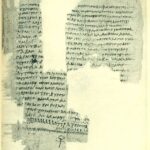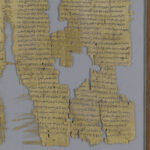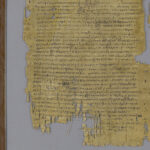| Artefact ID | 504 |
| TM ID | TM 61979 |
| Findspot (DEChriM ID) | - () | Class | Textual |
| Material | Papyrus |
| Writing medium | Codex |
| Text content | Literary |
| Language | Greek, Coptic |
| Description | Hamburger Papyrus bilinguis 1; Ap22 A large group (28 folios) of fragments from a papyrus codex containing the Acts of Paul (in Greek), the Coptic texts of Lamentations (Ezechiel) and the Canticum in the Fayumic dialect, as well as Ecclesiastes in Greek and Fayumic. The first three groups of fragments seem to have belonged to quires 1 and 2, the two remaining groups to quires 3 and 4. Pages 1-11: Acts of Paul, with end title (Greek - the beginning and middle is lost) It is estimated that the Acts of Paul comprised the first 19 pages of the codex, of which 11 pages survive; see Wayment 2013: 21. The Greek text is written in a single column, with approx. 32-44 lines of text per column, by at least two hands. The script is a sloping majuscule written in the severe style. Line-final καί irregularly appears as a ligature; the text also contains breathings, diaereses and apostrophes, and punctuation appears in the shape of high points. The text contains several nomina sacra. Final crux ansata. There were added two single folios at end of quire 2 so as to complete the transcription of the Lamentations, and there is only one extant page number. It appears at the top of page 50 (f. 29 verso) and marks it as page "8" of the Coptic Ecclesiastes. The execution of the text is filled with errors. According to J.-L. Fournet, the codex had an educational purpose and it is possible that the two copyists were bilinguals with a better command of Greek, trying to perfecting themselves in Coptic writing at the same time as they compiled collections of texts for personal use (Fournet 2019: 8, n. 15). |
| Selection criteria | Literary genre (Biblical), Literary genre (Non-canonical), Christian symbols/gestures/isopsephy, Nomina sacra, Coptic language |
| Date from | 276 |
| Date to | 350 |
| Dating criteria | The date is given on the palaeographical assessment in the ref. ed., following Eric F. Turner. According to a recent re-examination of the script, the end of the 3rd c. should be preferred (Fournet 2019: 9 referring to Crisci 2004: 114). |
| Absolute/relative date | Relative date |
| Archaeological context | The fragments were possibly found in Tebtunis (Arsinoites). Further information about the provenance is unknown. Acquired in 1927 by the Staats- und Universitätsbibliothek Hamburg. |
| Accession number | Hamburg, Bibliothek Pap. Bil. 1 [Hamburger Papyrus Bilinguis] |
ARTEFACT IDENTIFIERS
Reference edition:
• Diebner, Bernd Jørg, Rodolphe Kasser, Angelicus M. Kropp, Christian Voigt, eds. 1989. Hamburger Papyrus Bil. 1: Die alttestamentlichen Texte des Papyrus Bilinguis 1 der Staats- und Universitätsbibliothek Hamburg. Cahiers d'orientalisme 18. Hamburg.
Editio princeps:
• Schmidt, Carl, and Wilhelm Schubart. 1936. Praxeis Paulou = Acta Pauli : nach dem Papyrus der Hamburger Staats- und Universitäts-Bibliothek. Glückstadt: J.J. Augustin with pl.
Additional bibliography:
• Bastianini, Guido and Angelo Casanova, eds. 2011. I papiri letterari cristiani: atti del Convegno internazionale di studi in memoria di Mario Naldini, Firenze, 10-11 giugno 2010. Firenze. Plate no. 12.
• Crisci, Edoardo. 2004. "I più antichi codici miscellanei greci. Materiali per una riflessione". Segno e Testo 2. 109-144.
• Fournet, Jean-Luc. 2019. The Rise of Coptic. Egyptian versus Greek in Late Antiquity. Princeton-Oxford: Princeton University Press, 8-9.
• Geerard, Maurits. 1992. Clavis apocryphorum Novi Testamenti. Turnhout: Brepols. 117-126, no. 211.i.
• Kasser, Rodolphe. 1990. "A Standard System of Sigla for Referring to the Dialects of Coptic." Journal of Coptic Studies 1:141-151.
• Kurfess, Alfons. 1939. "Zu dem Hamburger Papyrus der Πράξεις Παύλου." Zeitschrift für die Neutestamentliche Wissenschaft und die Kunde der Älteren Kirche 38. 164-170.
• Lucchesi, Enzo. 1990. "La version copte de l'homélie LX de Sévère d'Antioche." Aegyptus 84 (1/2): 207-216.
• Peterson, Erik. 1949. "Einige Bemerkungen zum Hamburger Papyrus-Fragment der Acta Pauli." Vigiliae Christianae 3 (3). 142-62.
• Rahlfs, Alfred and Detlef Fraenkel. 2004 (1914). Verzeichnis der griechischen Handschriften des Alten Testaments. Göttingen. 134-138, descr. no. 998.
• Rordorf, Willy. 1988. "In welchem Verhältnis stehen die apokryphen Paulusakten zur kanonischen Apostelgeschichte und zu den Pastoralbriefen". Text and Testimony : Essays on New Testament and Apocryphal Literature in Honour of A. F. J. Klijn. Baarda, T. et al, eds. Kampen: Hok. 225-241.
• Schenke, Hans-Martin, and Walter Beltz. 1994. Der Gottesspruch in der koptischen Literatur: Hans-Martin Schenke zum 65. Geburtstag. Halle. 24-36.
• Schmidt, Karl. 1929. "Neue Funde zu den alten Πράξεις Παύλου". Sitzungsberichte der Preussischen Akademie der Wissenschaften 7. 173-183.
• van Haelst, Joseph. 1976. Catalogue des papyrus littéraires juifs et chrétiens. Paris. Description no. 263 and 605.
• Wayment, Thomas A. 2013. The text of the New Testament apocrypha (100-400 CE). London. 21-31, 227-237.
• Zwierlein, Otto. 2009. Petrus in Rom. Unters. zur antiken Literatur und Geschichte 96. Berlin, New York: De Gruyter. 342, 426-449.
• ———. 2011. "Griechische Papyri in der Überlieferung der Acta Apostolorum Apocrypha". I papiri letterari cristiani. Bastianini, Guido and Angelo Casanova, eds. Studi e Testi di Papirologia NS 13. Firenze. 129-130.


 Json data
Json data





